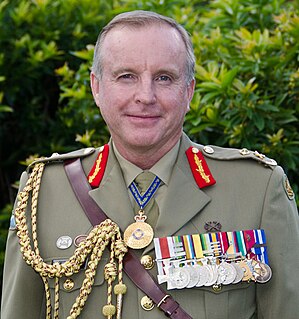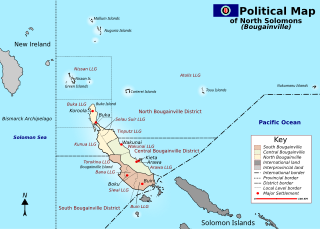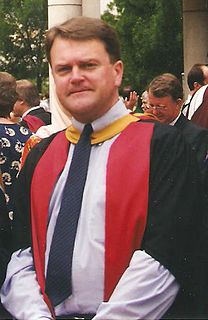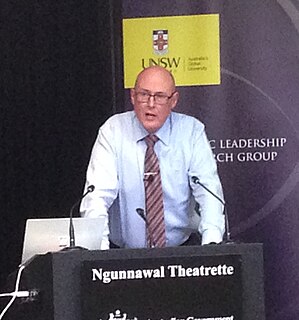
The Australian Army is the principal land warfare force of Australia, a part of the Australian Defence Force (ADF) along with the Royal Australian Navy and the Royal Australian Air Force. The Army is commanded by the Chief of Army (CA), who is subordinate to the Chief of the Defence Force (CDF) who commands the ADF. The CA is also directly responsible to the Minister for Defence, with the Department of Defence administering the ADF and the Army.

The Special Air Service Regiment, officially abbreviated SASR though commonly known as the SAS, is a special forces unit of the Australian Army. Formed in 1957, it was modelled on the British SAS sharing the motto, "Who Dares Wins". The regiment is based at Campbell Barracks, in Swanbourne, a suburb of Perth, Western Australia, and is a direct command unit of the Special Operations Command. It has taken part in operations in Borneo, Vietnam, Somalia, East Timor, Iraq and Afghanistan, as well as many other peacekeeping missions. The SASR also provides a counter-terrorist capability, and has been involved in a number of domestic security operations.
The Peace Monitoring Group (PMG) on Bougainville in Papua New Guinea was brought about by the civil unrest on the island in 1989. The PNG government requested the Australian and New Zealand governments to provide a monitoring group to oversee the cease fire on the island. This group was made up of both civilian and defence personnel from Australia, New Zealand, Fiji and Vanuatu. Both sides of the conflict welcomed the group being on Bougainville. This support remained strong throughout the PMG's deployment. The PMG played a role in facilitating the peace process on 30 April 1998 and took over from the New Zealand Truce Monitoring Group which then departed.

The International Force East Timor (INTERFET) was a multinational non-United Nations peacemaking task force, organised and led by Australia in accordance with United Nations resolutions to address the humanitarian and security crisis that took place in East Timor from 1999–2000 until the arrival of UN peacekeepers. INTERFET was commanded by an Australian military officer, Major General Peter Cosgrove.

Australia was a member of the international coalition which contributed military forces to the 1991 Gulf War, also known as Operation Desert Storm. More than 1,800 Australian Defence Force (ADF) personnel were deployed to the Persian Gulf from August 1990 to September 1991, while contingents from the Royal Australian Navy circulated through the region in support of the sanctions against Iraq until November 2001. In August 1990, two frigates HMAS Adelaide and HMAS Darwin and the replenishment ship HMAS Success left for the Persian Gulf. HMAS Success had no air defences, so the Army 16th Air Defence Regiment was embarked. On 3 December 1990, HMAS Brisbane and HMAS Sydney (IV) relieved HMAS Adelaide and HMAS Darwin. On 26 January 1991, HMAS Westralia replaced HMAS Success. A Navy clearance diving team was also deployed for explosive ordnance disposal and demolition tasks. Australian ships were in danger of sea mines and possible air attacks. In a number of recorded incidents, HMAS Brisbane encountered free floating mines, on one occasion narrowly avoiding a collision. Both HMA Ships Brisbane and Sydney encountered significant air threat warnings from Iran and Iraq throughout the initial period of the commencement of the Desert Storm Campaign. The detection of land based Silkworm anti-ship missiles from Iran throughout the campaign also added to the challenges for both crews as well as the multi-national Naval Forces.

Operation Morris Dance was an Australian military operation conducted in May 1987 in response to the first of the 1987 Fijian coups d'état.

Operation Quickstep was the name given to the deployment of military resources by the Australian Defence Force during the leadup to the 2006 Fijian coup d'état on 4–5 December 2006, during which the Fijian military took control of the Fijian government which, at the time, was led by Prime Minister Laisenia Qarase. The intention behind deploying the military resources was to provide a platform for the evacuation of Australian citizens and nationals in the event of a violent military takeover of the Pacific nation.
David Murray Horner, is an Australian military historian and academic.
Australia was one of the founding members of the United Nations (UN) in 1945 and has been actively engaged in the organisation since its formation. The UN is seen by the Australian Government as a means to influence events which directly affect Australia's interests but over which they have little unilateral control.

Major General John Patrick Cantwell, is a retired senior Australian Army officer.

Australian military involvement in peacekeeping operations has been diverse, and included participation in both United Nations sponsored missions, as well as those as part of ad hoc coalitions. Indeed, Australians have been involved in more conflicts as peacekeepers than as belligerents; however, according to Peter Londey "in comparative international terms, Australia has only been a moderately energetic peacekeeper." Although Australia has had peacekeepers in the field continuously for 60 years – the first occasion being in Indonesia in 1947, when Australians were among the first group of UN military observers – its commitments have generally been limited, consisting of small numbers of high-level and technical support troops or observers and police. David Horner has noted that the pattern changed with the deployment of 600 engineers to Namibia in 1989–90 as the Australian contribution to UNTAG. From the mid-1990s, Australia has been involved in a series of high-profile operations, deploying significantly large units of combat troops in support of a number of missions including those in Cambodia, Rwanda, Somalia and later in East Timor. Australia has been involved in close to 100 separate missions, involving more than 30,000 personnel and 10 Australians have died during these operations.
Rosemarie Gillespie, also known as Waratah Rose, was an Australian lawyer, human rights activist, author and film producer. She was active in human rights causes in Australia, the USA, Melanesia, the Pacific Islands and the Middle East for more than forty years.

The Bougainville conflict, also known as the Bougainville Civil War, was a multi-layered armed conflict fought from 1988 to 1998 in the North Solomons Province of Papua New Guinea (PNG) between PNG and the secessionist forces of the Bougainville Revolutionary Army (BRA), and between the BRA and other armed groups on Bougainville. The conflict was described by Bougainvillean President John Momis as the largest conflict in Oceania since the end of World War II in 1945, with an estimated 15,000–20,000 Bougainvilleans dead, although lower estimates place the toll at around 1,000–2,000.

Jeffrey Guy Grey was an Australian military historian. He wrote two volumes of The Official History of Australia's Involvement in Southeast Asian Conflicts 1948–1975, and several other high-profile works on Australia's military history. He was the first non-American to become the president of the Society for Military History, but is perhaps best known as the author of A Military History of Australia.
Peter Geoffrey Edwards, AM is an Australian diplomatic and military historian. Educated at the University of Western Australia and the University of Oxford, Edwards worked for the Department of Foreign Affairs, the Australian National University and the University of Adelaide before being appointed Official Historian and general editor of The Official History of Australia's Involvement in Southeast Asian Conflicts 1948–1975 in 1982. The nine-volume history was commissioned to cover Australia's involvement in the Malayan Emergency, Indonesia–Malaysia confrontation and Vietnam War. Edwards spent fourteen years at the Australian War Memorial (AWM) writing two of the volumes, while also researching, editing, and dealing with budget limitations and problems with staff turnover. Since leaving the AWM in 1996, Edwards has worked as a senior academic, scholar and historical consultant. In 2006 his book Arthur Tange: Last of the Mandarins won the Queensland Premier's History Book Award and the Western Australian Premier's Book Award for Non-Fiction.
The Official History of Australian Operations in Iraq and Afghanistan, and Australian Peacekeeping Operations in East Timor is an Australian official history series currently under preparation. It was approved by the Australian Government in 2015, and is due to be completed by mid-2022.

Craig Anthony John Stockings is an Australian historian with research interests in military and defence history. Since 2016, Stockings has been Official Historian and general editor of the Official History of Australian Operations in Iraq and Afghanistan, and Australian Peacekeeping Operations in East Timor, based at the Australian War Memorial in Canberra. Prior to this appointment, Stockings was an officer in the Australian Army and professor of history at the University of New South Wales, Canberra, working out of the Australian Defence Force Academy.
Alan John Sweeting,, known as Bill Sweeting, was an Australian historian and museum administrator.
The South Pacific Peacekeeping Force (SPPKF) was an Australian-led peacekeeping force established during the Bougainville Civil War. Hastily established to provide security for peace talks around Arawa, the force consisted of an infantry security force, supported by various logistic and aviation assets, which were deployed and air and sea from Australia. Troops were drawn from Australia, New Zealand, Tonga, Vanuatu and Fiji. The force was deployed between 4 and 21 October 1994 before being withdrawn. Further peacekeeping troops were deployed to the island in 1997 as part of the Truce Monitoring Group.











